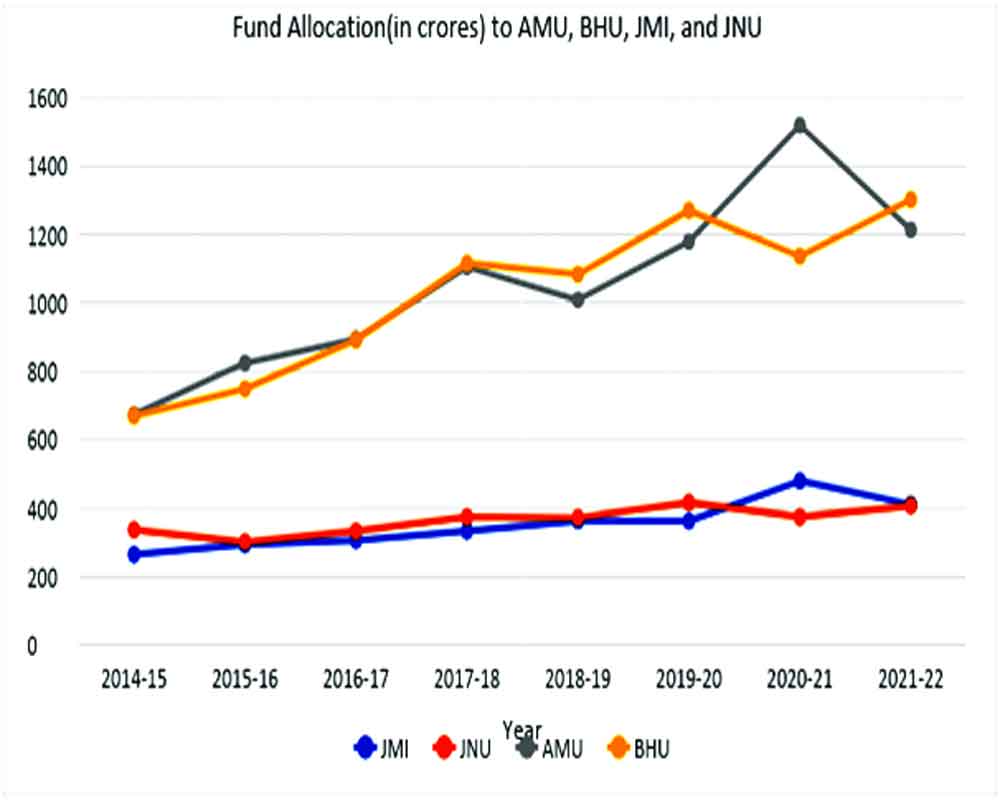The fund allocation to any entity (whether State or educational institutions or sector or any other project) has always been used as a yardstick to measure the priority and preference of any Government.
The issue becomes more sensitive when it is related to higher education institutions, especially in the present context when these institutions have become highly politicised and are perceived to be aligned to particular ideological and party lines.
The case in point is a news item doing rounds in the media that the Central Government has doubled the budget allocation to Banaras Hindu University (BHU) while the fund allocation to Aligarh Muslim University (AMU) and Jamia Millia Islamia (JMI) has been sharply reduced.
It all began with TN Prathapan, a Lok Sabha member, asking an unstarred question (No. 131) related to fund allocation to some of the Central universities in India. The question was “whether the Government has the details of fund allocation to these universities: Jawaharlal Nehru University (JNU); Jamia Millia Islamia (JMI); Aligarh Muslim University (AMU);
Rajiv Gandhi University, Itanagar (RGU); Banaras Hindu University (BHU); and if so, the details thereof since 2014?”.
The question was replied to on July 18 this year in Parliament, and within a day of replying, a lot of mainstream newspapers and news websites (National Herald, The Wire, Free Press Kashmir, Ground Report, Navjeevan Express, etc., here onwards called news publications), mis-reported the reply in a manner which suggested that the Government of India is reducing the budget of only Muslim minority institutions, and is hence completely against the Muslim community.
Even a famous education portal Careers360.com and YouTube channel (https://www.youtube.com/watch?v=uQSntR4h3Yg) too reported the same thing (see Table-1).
However, a look at the unedited table (table-2) provided by the Ministry of Education in their reply to the unstarred question of said parliamentarian itself reveals the truth. A few points are noteworthy:
n The sharpest increase in the annual fund in the year 2020-21 compared to the same in 2014-15 was of RGU (143%) followed by AMU (125%), JMI (81%), BHU (69%) and JNU (10%).
n Even the fund allocation for the year 2021-22 compared to 2014-15 shows that the sharpest increase was noticed in RGU (157%) followed by BHU (94%) AMU (80%), JMI (55%) and JNU (20%).
n The year-to-year analysis shows a mixed picture. In the year 2014-15, 2015-16, 2016-17 and 2020-21, the fund allocated to AMU had been higher than BHU, while in the years 2017-18, 2018-19, 2019-20 and 2021-22, the fund allocation to BHU was higher than AMU.
n The budget allocation to JMI and AMU increased by 32.6 per cent and 28.8 per cent respectively in 2020-21 compared to the previous year while the same fell by 10.5 per cent for BHU. Interestingly, none of the publications in question ever reported this phenomenon but they produced an incomplete picture by only considering the figures of the very next year when the budget allocation for JMI and AMU decreased by 14.3 per cent and 20.1 per cent respectively while the same increased for BHU by 14.6 per cent.
n The total fund allocation in the last 8 years, from 2014-15 to 2021-22, was Rs 8,223 crore for BHU, while for AMU it was Rs 8,424 crore, which is clearly Rs 201 crore higher than that of BHU.
n The real value (adjusted for inflation) of the total allocation in these 8 years also shows the same result (total allocation to AMU was higher than BHU).
We have confined our analysis to just fund allocation to each of these institutions to determine if BHU is being given preference over or at the cost of others since these news publications have just used this criterion to make comparisons. There are many other factors responsible for the fund allocation i.e. institution of eminence (IoE), number of new courses introduced, permanent faculty recruitment, scholarships, etc, which we are leaving out for the sake of brevity and understandability.
It raises serious doubts as to why so many news publications have come to the same erroneous conclusion based on the same data set within such a short time. It is important to notice that all of these publications have credited the story to their own reporters or news desks.
More importantly, the headlines used indicate that they came to the same perverted and wrong conclusion given the same data. It is said while the same correct answer cannot be conclusive proof of copying in an exam, the same wrong answer is a definite proof of collusion.
The biased news publications sow seeds of hatred in the hearts of the youth of the Muslim community against the elected Government of the nation.
They can be seen doing this for a long time, and such acts are only increasing the gap between various religious groups, doing great harm to the integrity and unity of the nation, apart from tarnishing the image of the country across the globe.
It is also surprising that despite the hard numbers being available in black and white in the public domain, the so-called vigilant fact-checkers have chosen to remain mute spectators in this case.
(Views are personal. Anish Gupta teaches at Delhi University and Abhinandan Basu is a law graduate from Delhi University.)
























